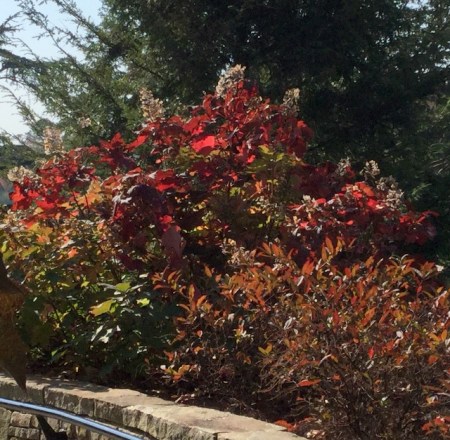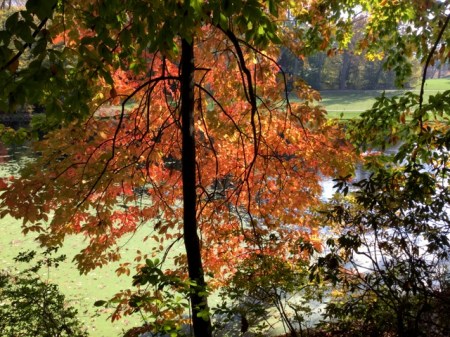Carolyn’s Shade Gardens is a retail nursery located in Bryn Mawr, PA, specializing in showy, colorful, and unusual plants for shade. The only plants that we ship are snowdrops and miniature hostas. For catalogues and announcements of events, please send your full name, location, and phone number (for back up use only) to carolyn@carolynsshadegardens.com. Click here to get to the home page of our website for catalogues and information about our nursery and to subscribe to our blog.
 The very showy flowers of redvein enkianthus, Enkianthus campanulatus ‘Princeton Red Bells’.
The very showy flowers of redvein enkianthus, Enkianthus campanulatus ‘Princeton Red Bells’.
My nursery specializes in herbaceous flowering plants for shade. However, although no shade garden is complete without trees, shrubs, and vines, our local nurseries seem to ignore woody plants for shade. To fill this gap, I offer shade-loving woodies from a wholesale grower whose quality meets my exacting standards. To view the catalogue, click here. As in Woody Plants for Shade Part One, I thought my blog readers who are not customers might be interested in learning about the woody plants that I would recommend they add to their shade gardens. And doing an article in addition to the catalogue allows me to add more information so customers might be interested also.
Included in my offering are six shrubs and two vines. Of the eight plants I have chosen, five are native. Please read my article My Thanksgiving Oak Forest to see why I think planting native plants is crucial to our environment. My article New Native Shade Perennials for 2011 explains why I think native cultivars are valuable native plants. With that introduction, here are the plants I am highlighting:
 Native bottlebrush buckeye, Aesculus parviflora
Native bottlebrush buckeye, Aesculus parviflora
Native bottlebrush buckeye is a wonderful shrub for making a majestic stand in full shade. I grow it deep in my woods, and it performs beautifully. It grows to 10’ tall in full sun to full shade in any location and soil type. It is also deer resistant. The creamy white flowers on long upright brush-like panicles in early summer and the bold textured leaves give it a dramatic tropical look. It has excellent yellow fall color and attracts hummingbirds.
 The lovely yellow fall color of bottlebrush buckeye.
The lovely yellow fall color of bottlebrush buckeye.
Bottlebrush buckeye is native to parts of the eastern US, including Pennsylvania. It is a Pennsylvania Horticultural Society Gold Medal Plant, click here for details. It is also a Missouri Botanical Garden Plant of Merit, click here for details (photos courtesy of the Missouri Botanical Garden Plant Finder).
 Dwarf slender deutzia, Deutzia gracilis ‘Nikko’
Dwarf slender deutzia, Deutzia gracilis ‘Nikko’
‘Nikko’ dwarf slender deutzia is another shrub that can grow anywhere from full sun to full shade and is deer resistant. In April and May, it is covered with delicate white flowers, and the fine-textured and neat green leaves turn purple in the fall. This deutzia makes an excellent specimen, growing 2’ tall by 5’ wide, or a superior flowering groundcover for shade. I grow it in full shade at the base of my winterberry hollies. It is native to Japan and is a Pennsylvania Horticultural Society Gold Medal Plant, click here for details.
 I use ‘Nikko’ dwarf slender deutzia as a groundcover in full shade under winterberry hollies.
I use ‘Nikko’ dwarf slender deutzia as a groundcover in full shade under winterberry hollies.
 Redvein enkianthus, Enkianthus campaulatus ‘Princeton Red Bells’
Redvein enkianthus, Enkianthus campaulatus ‘Princeton Red Bells’
In May ‘Princeton Red Bells’ redvein enkianthus is covered with a multitude of spectacular deep red, pendant bell-like flowers. Its elegantly arranged blue-green leaves turn an excellent dark red in the fall. It has a very unique and graceful habit (see photo of species below) and grows to 8’ tall by 4’ wide in full sun to full shade. It is deer resistant and likes average to moist soil, although I grow it in my dry woodland. It is native to Japan. For more information about the species, click here.
 This photo of the straight species of redvein enkianthus growing in my woodland shows its elegant habit and abundance of flowers. The flowers of ‘Princeton Red Bells’ are much more eye-catching.
This photo of the straight species of redvein enkianthus growing in my woodland shows its elegant habit and abundance of flowers. The flowers of ‘Princeton Red Bells’ are much more eye-catching.
 The amazing flowers of native smooth hydrangea, Hydrangea arborescens ‘Annabelle’.
The amazing flowers of native smooth hydrangea, Hydrangea arborescens ‘Annabelle’.
Native ‘Annabelle’ smooth hydrangea has won numerous awards for its very showy, huge (up to 1’) snowball flowers, which appear from June into September. It grows 5’ tall by 5’ wide in part to full shade (full sun is not recommended). It is supposed to be deer resistant for a hydrangea. A gentle pruning in late spring produces optimum growth.
 ‘Annabelle’ produces copious, long lasting flowers.
‘Annabelle’ produces copious, long lasting flowers.
Smooth hydrangea is native to the eastern U.S., including Pennsylvania. It is a Pennsylvania Horticultural Society Gold Medal Plant, click here for details. It is also a Missouri Botanical Garden Plant of Merit, click here for details (photos courtesy of the Missouri Botanical Garden Plant Finder).
 The gorgeous and delicious fruit of native northern highbush blueberry, Vaccinium corymbosum ‘Jersey’.
The gorgeous and delicious fruit of native northern highbush blueberry, Vaccinium corymbosum ‘Jersey’.
Gardeners might not think of northern highbush blueberry as an ornamental, but it has everything you could want in a shrub. Its pretty bell-shaped white flowers appear in May and are followed by delicious and beautiful powder blue fruit in summer. It has excellent scarlet fall color and is native and wet site tolerant. What more could you ask for? It grows to 6’ tall in full sun to part shade.
 The flowers of northern highbush blueberry
The flowers of northern highbush blueberry
Northern highbush blueberry is native to all of eastern North America, including Pennsylvania. I am offering two cultivars: ‘Jersey’ is an early midseason producer, and ‘Berkley’ is late midseason. Planting two different cultivars produces better fruit. For more information, click here (photos of berries and fall color courtesy of the Missouri Botanical Garden PlantFinder).
 The fall color of northern highbush blueberry.
The fall color of northern highbush blueberry.
 Doublefile viburnum, Viburnum plicatum var. tomentosum
Doublefile viburnum, Viburnum plicatum var. tomentosum
My doublefile viburnum, pictured above, is one of the showiest and most talked about plants in my display gardens. ‘Mariesii’ is a superior cultivar of doublefile viburnum. Its large, white lacecap flowers in May and June and elegant, pleated medium green leaves are an unbeatable combination. It grows quickly up to 12’ tall and 10’ wide in part to full shade and is deer resistant. It is native to China and Japan. For more information, click here.
 The flowers of doublefile viburnum.
The flowers of doublefile viburnum.
 Native trumpet honeysuckle, Lonicera sempervirens ‘Crimson Cascade’
Native trumpet honeysuckle, Lonicera sempervirens ‘Crimson Cascade’
Native ‘Crimson Cascade’ trumpet honeysuckle produces bright coral red tubular flowers that invite hummingbirds from miles around in late spring and reblooms through fall. Its shiny dark green leaves with red stems remain attractive through the season. It is native to all of eastern North America, including Pennsylvania. I grow mine mixed with my wisteria on my front porch and in an even shadier location along my front stairs.
 Trumpet honeysuckle climbs my Chinese wisteria and blooms before, during, and after the wisteria is done.
Trumpet honeysuckle climbs my Chinese wisteria and blooms before, during, and after the wisteria is done.
 Native American wisteria, Wisteria frutescens ‘Amethyst Falls’
Native American wisteria, Wisteria frutescens ‘Amethyst Falls’
The copious fragrant, lavender-blue flower clusters of ‘Amethyst Falls’ American wisteria are almost as beautiful in bud as in bloom from June to August. This wisteria has fine-textured attractive foliage and is less rampant than Asian wisteria. It grows to 20′ at maturity in full sun to part sun (it is technically not a shade plant). It is native to the eastern U.S., including Pennsylvania. ‘Amethyst Falls’ is a Pennsylvania Horticultural Society Gold Medal Plant, click here for details.
 The flowers and foliage of American wisteria.
The flowers and foliage of American wisteria.
I grow every one of these shrubs and vines in my gardens so I know you can’t go wrong by adding them to yours! If you are a customer, you have until May 25 to place an order by clicking here. If not, now you have some plants to ask for at your local independent nursery.
Carolyn
Notes: Every word that appears in orange on my blog is a link that you can click for more information. If you want to return to my blog’s homepage to access the sidebar information (catalogues, previous articles, etc.), just click here.
Nursery Happenings: Orders for woody shade plants will be accepted until noon on Wednesday, May 25. We will have our traditional open hours over Memorial Day Weekend on Saturday from 9 am to noon and Sunday from noon to 3pm. You don’t need an appointment, just show up. But remember you can make an appointment to shop 24/7 by sending me an email at carolynsshadegardens@verizon.net. There is still a great selection of hostas, ferns, and hardy geraniums.










 ‘Prairie Sentinel’ pond cypress, Taxodium ascendens, has a more upright habit than its cousin the bald cypress and is native just south of PA.
‘Prairie Sentinel’ pond cypress, Taxodium ascendens, has a more upright habit than its cousin the bald cypress and is native just south of PA.
























